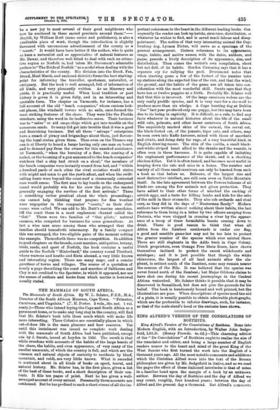THE MAMMALS OF SOUTH AFRICA.
The Mammals of South Africa. By W. L. Sclater, F.Z.S., M.A., Director of the South African Museum, Cape Town. "Primates, Carnivore, and Ungulate." (T.'. H. Porter. 2 vols., 30s. net. 1 vol. ready.)—Those who intend trying the Cape and South Africa as a permanent home, or to make any long stay in the country, will find that Mr. Sclater's book tells them much which will make life more interesting. These Colonies are essentially places in which out-of-door life is the main pleasure and best resource. Yet until this instalment was issued no complete work dealing with the mammals of South Africa had been published, except one by J. Smuts, issued at Leyden in 1832. The result is that while overdone with accounts of the habits of the large beasts of the chase, the habits, and even appearance, of very many of the smaller mammals, of which the country is full, and which are the common awl natural objects of curiosity to residents by kloof, mountain, and veldt, are very little known. What is recorded is scattered about in all kinds of books on sport, travel, and natural history. Mr. Sclater has, in the first place, given a list of the best of these books, and a short description of their con- tents. It fills ten pages of print. Next he has given a well- arranged account of every animal. Necessarily these accounts are condensed. But he has prefixed to each a short résumé of all the im- portant references to the beast in the different leading books. Con sequently the reader can look up habits, structure, distribution, ot whatever he wishes to find, and is saved much labour and disap. point went. The notice of that very interesting animal the Cape hunting dog, Lycaon Pictus, will serve as a epoch:Gen of tho general arrangement. Sixteen references to its appearance, range, habits, and native names, with the dates, authors, and pages, precede a lively description of its appearance, size, and distribution. Then comes the writer's own compilation, short but not dull, of its habits. Gordon Cumming says that it has a separate cry for rallying the pack. Drummond notes that when starting game a few of the fastest of the number take up stations along the expected line of the run, and that the wind, the ground, and the habits of the game are all taken into con- sideration with the most wonderful skill. Smuts says that they have ten or twelve puppies at a birth. Probably Mr. Sclater will find that this is incorrect. Of the large carnivore wolves are the only really prolific species, and it is very rare for a she-wolf to produce more than six whelps. A Cape hunting dog at Dublin " Zoo " last year produced only one puppy, but this may have been due to its being in captivity. It is difficult, as a rule, to find any facts whatever in natural histories about the life of the small wild cats, polecats, and other lesser carnivore of South Africa. The exquisitely marked skins of the caracal, the serval cat, the black-footed cat, of the jennets, tiger cats, and others, may be seen sewn into Kaffir karosses, mixed with those of meerkats and civets, and doing duty for rugs, of a very beautiful kind, in English drawing-rooms. The skin of the zorilla, a small black- and-white-striped beast allied to the skunks and the weasels, is often seen in these karosaes. It is quite capable of imitating the unpleasant performances of the skunk, and is a shocking chicken-killer. Yet it is often tamed, and becomes most useful in keeping down the rats and mice in a house. The number and variety of all these small carnivore can only be learned from such a book as that before us. Baboons, of the largest size and most destructive intellect, are still seen even on Table Mountain itself. In the late agreement between the Powers baboons of all kinds are among the few animals not given protection. They have added to their other forms of mischief the sucking of ostrich eggs, and a taste for killing lambs and kids for the }take of the milk in their stomachs. They also rob orchards and steal corn, as they did in the days of " Masterman Ready." Modern authors have written almost nothing about their habits, the last reference to them being in a letter by two officers escaping from Pretoria, who were stopped in crossing a river by the appear- ance of a troop of these formidable beasts coming down to drink. There is good reason to think that when all Africa from the Zambesi southwards is under our flag, a good and sensible game-law may not be too late to protect the greater number of the species which ever existed there. There are still elephants in the Addo bush in Cape Colony. Dutch proprietors, even Orange Free State Boers, have shown themselves inclined to protect the rarest wildebeests and antelopes ; and it is just possible that though the white rhinoceros, the largest of all land animals after the ele- phant, is extinct south of the Zambesi, some may remain nearer the sources of the Nile. It was believed that the species was never found north of the Zambesi; but Major Gibbons claims to have shot one during his recent journeyings in the Central African watershed. Mr. Sclater thinks it possible that it may be discovered in Somaliland, but does not give the grounds for his belief. The book is handsomely bound and well printed, but the illustrations are poor. When descriptions of species need the aid of a plate, it is usually possible to obtain admirable photographs, which are far preferable to inferior drawings, such, for instance. as that of the male eland's head or the suricate here shown.


















































 Previous page
Previous page